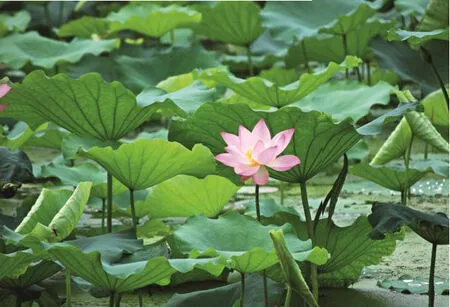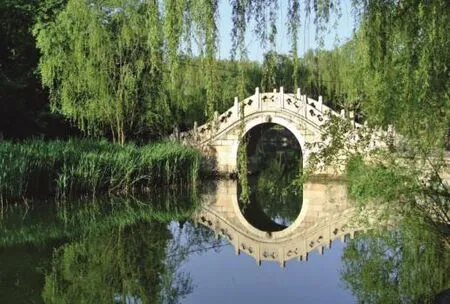THE LOTUS POND LINGERING IN MY MEMORY
2018-11-05ByLiJianchen
By Li Jianchen
The lotus pond described by Zhu Ziqing (1898-1948) in his essay “The Moonlit Lotus Pond” has continued to mesmerize me for many years.
When I walked through the gate of Tsinghua University decades ago, my first item of business was to visit the pond as soon as possible.
I remember our class's first tour of campus. A classmate who arrived with a new camera became the focus of the whole class. After some hot and noisy exchange of ideas, they chose several locations for class photo shoots. The first was Gongzi Hall, an I-shaped building constructed during the reign of Qing Dynasty Emperor Qianlong(reign 1736-1795) featuring carved beams, painted rafters,upturned eaves and a board hanging over its lintel carrying an inscription by Emperor Xianfeng (reign 1850-1861).Next was the Hall of Tsinghua School, an example of classical German architecture from the country that first organized the institution. The third one was the famous scenic site north of the Gongzi Hall, where antique pavilions overlook a pool of clear water surrounded by wellwooded hills. The fourth was the Grand Auditorium, a fusion of ancient Greek and Byzantine styles.
Considering this list, I could hardly muster the courage to suggest the lotus pond.
Before long, we were led by a teacher to a place called “Barren Island” in the northwest corner of campus to participate in voluntary labor, where we would dig and clean sludge. I dared ask the teacher where the lotus pond was. His answer shocked me: “This ditch you are dredging now is that lotus pond.”
What a twist of fate! Facing that messy and desolate ditch, I was overwhelmed by a despondent feeling of loss.Where was the lotus pond that had been gripping my mind,that I had always dreamed of witnessing? At that moment,a line of an ancient Tibetan poem came to mind: “Alas! Ever to meet is to know! If ever is as such, better not to meet.”
So-called “Barren Island”was an earth mound covering an area of about 1.6 acres. With its south side flat and the other three swelling up roughly four meters high, it appeared like a giant chair facing south. Around it was a moat resembling a jade belt, and to the south of the moat stood another earth mound serving as its “screen wall.” On “Barren Island” were trees with twisting and coiling branches, shadowing the broken tiles and rotten wood pieces remaining scattered among the still discernible ruins. To its northwest was a white marble arch bridge which crossed over the ditch, hinting at a once scenic spot, while to the southeast was a wooden zigzagging bridge extending to the other side, seemingly leading to seclusion. Despite its dilapidated appearance, “Barren Island” maintained a neat and orderly layout, emitting a unique flavor of its own.

Lotus in Spring Approaching Garden.
In the spring of the next year, a stone tablet was erected on “Barren Island” with the inscription “Relic Site of Spring Approaching Garden,” which finally revealed to me its previous incarnation.
During Qing Emperor Kangxi’s reign (1662-1722), the imperial court collected rare rocks and wood from each quadrant of China for a large scale construction project. To the northwest of Beijing, three hills and five gardens were constructed. The site of “Barren Island” was the core of Bright Spring Garden, one of the five,and it was bestowed to Yinzhi,the third son of the emperor. In the garden, the prince organized numerous scholars who compiled pages upon pages of books including unprecedented and monumental projects such as Compendium of Works of Past and Present and Origination of Calendars, Tunes and Mathematics. Across the hundred years afterwards,the Bright Spring Garden was expanded, and during Emperor Daoguang’s reign (1821-1850),it was divided into two parts,one of which was renamed“Spring Approaching Garden”and gifted to the fourth son of the emperor, who later became Emperor Xianfeng of the Qing.
With what is now “Barren Island” at its center, the Spring Approaching Garden was built in the pattern of a city surrounded by a moat.Back then, towering ancient trees exuberantly surrounded fantastic rocks and shielded shiny lotus flowers and boundless verdant leaves. Long bridges crossed the ripples against winding corridors with carved railings and jade inlays. Imbued with the sort of beautiful scenery praised by ancient Chinese poets, the garden was a fairyland on earth,in its day.
At the age of 19, Xianfeng left the garden for the Forbidden City as a confident man ready for heroic deeds. However,his timing proved poor, for what awaited was bad fortune.Soon after his accession to the throne in 1850, peasant groups of Taiping rebelled against the Qing government. Confronted by the Taiping forces, he suffered another strike with the outbreak of the Second Opium War in 1860. He had to flee to Rehe (now northern Hebei) and died there a year later.
During his reign, half of the empire fell into the hands of the Taiping army, the imperial capital was captured by foreigninvaders who destroyed Yuanmingyuan Imperial Garden, and 1 million square kilometers of territory was ceded to Tsarist Russia. For Qing regime, the era represented a critical turning point.

The stone tablet with the inscription“Relic Site of Spring Approaching Garden”.
On the glistening ripples are starry lotus flowers and masses of fresh leaves, with a background of exquisite pavilions on terraces, thriving willows over velvet grasses, chirping orioles among willow branches and dancing kites in the sky.
Later, despite severe calamity spreading throughout the country, Empress Dowager Cixi ignored all dissenting views to carry out her big plan of rebuilding Yuanmingyuan Imperial Garden. Her method of raising funds was to sell ranks of nobility, demand donations and increase taxation. She also conceived an idea of reappropriating local resources. Consequently, the Spring Approaching Garden was demolished and all the materials of any value taken away for her own use. But with the worsening political situation in the empire, her rebuilding scheme failed, and Spring Approaching Garden was deserted. The once lively imperial garden fell into ruin,deteriorating into a dreary scene of old willows and rotting grass, with only a few caws of crows at dusk.
The year 1913 saw “Barren Island” become part of the campus of Tsinghua. In 1927 when Zhu Ziqing rambled alone about the moonlit pond,despite the enjoyable tiers of lotus leaves and wafts of subtle fragrance, the way he walked on was, as described in the essay,“a meandering narrow cinder path,” and “taken by few people even in the daytime.” The pond was enveloped in loneliness,and especially at dusk it stirred up sadness. Only when in dim moonlight under the mottled shadows of trees could the lotus pond escape desolation to appear like “the flared skirts of dancing girls” and “beauties fresh from bathing,” phrases which broke into and torn at readers' imagination.
After a century of dead silence, “Barren Island”eventually reawoke at daybreak of a new era.When spring returned to the earth and everything came back to life, all teachers and students of Tsinghua joined hands in revitalizing it until it had taken on a completely new look.
Today, while roaming around the pond, things look different. On the glistening ripples are starry lotus flowers and masses of fresh leaves, with a background of exquisite pavilions on terraces, thriving willows over velvet grasses,chirping orioles among willow branches and dancing kites in the sky. There are kids playing in the corridors, fishers angling by the pond, young painters lost in landscapes and the elderly playing instruments passionately. Sounds of readings echoing from atop the hill accentuate the aroma of coffee brewing in a nearby café. The epigraph of the lotus pavilion is imbued with its writer's strong character,and the inscriptionless stone tablet manifests a mind free from desire for fame and gain.Brimming with vigor, the lotus pond has never been livelier.

A bridge in Spring Approaching Garden.
Across the ages, the lotus flower has been endowed with rich cultural status and spiritual connotations. Both Buddhism and Daoism adore it as something holy. When the lotus flower opens, its nature is on full display—not only because it is pure and dainty in beauty,but also because it grows in the mud yet emerges pristinely and blooms in limp ripples. It seems otherworldly, but can never be displaced. I was once surprised to learn that the lotus is capable of blooming even after a thousand years of dormancy. I heard about its status as a living fossil evidencing biological evolution,which already existed on our planet 135 million years ago. It survived the abrupt change of climate in the Cretaceous period and accompanied dinosaurs for tens of millions of years until they were lost to extinction.It is a stunner among flowers,and a biological wonder. Having endured monstrous sea waves,does it care about the sludge and muddy water of a pond?Its ability to stay pure in a filthy environment and free from contamination while injecting bright colors into this world makes it a perpetually beautiful sight that inspires hope. Just as Maugham once wrote, “If you look on the ground in search of a sixpence, you don't look up, and so miss the moon.”
In fact, by blooming under the moonlight, the lotus stays free from halo and filth, hustle and flippancy, splendor and tribulation,worldliness and annoyance. By cherishing placidity and indifference to fame or gain, it approaches action through non-action—the essence of life. Heaven has its own laws, and things are as they are. I wonder whether such understanding was the reason Mr. Zhu Ziqing roamed the lotus pond under the moonlight.
Is my understanding the same as what Su Dongpo (1037-1101) conveyed in the poem he composed while sightseeing on moonlit West Lake?
On the boundless lake in the dark of night,
Booming lotus flowers perfume the dewy breeze.
Having seen the distant temple's glimmering lamp produce light,
I can wait for moonset and enjoy a different sight.
